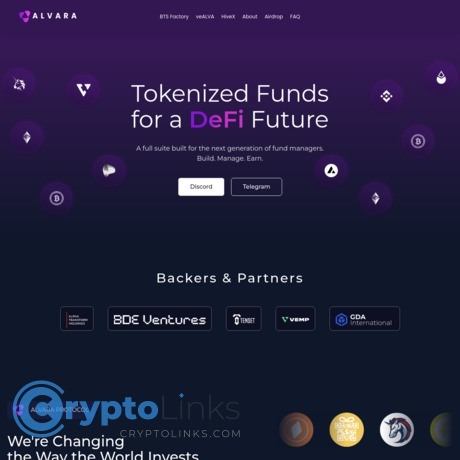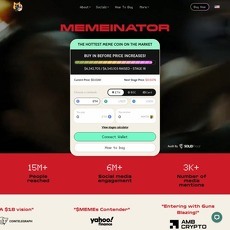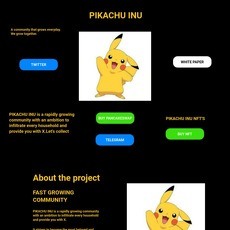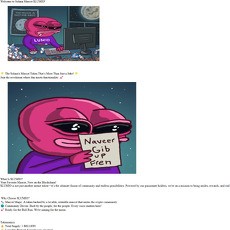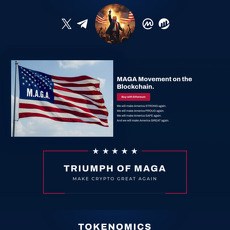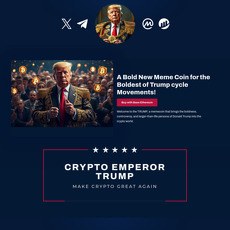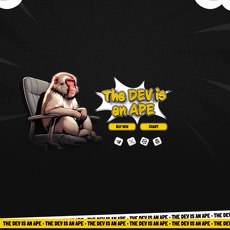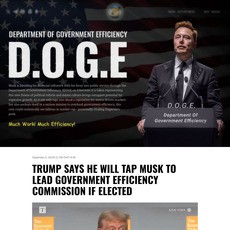Alvara Protocol Review
Alvara Protocol
alvaraprotocol.io
If your website is on the scam list and you think that you are not a scammer, contact us. After you provide us with all the proof that you are in Crypto World with good intentions, we will delist you. Usually, you get in this category because you are hiding your team, you have a bad reputation(you are tricking, deceiving, scamming people), and you haven't got a written project whitepaper or is a shitty one....
Their Official site text:
Alvara Protocol
[Problem/Solution & Background White Paper — Final —
February 15th, 2024 - The Alvara Team]
Abstract
This paper presents the Alvara Protocol. An industry first, Alvara provides key infrastructure
facilitating the creation of fully decentralized, meritocratic, tokenized cryptocurrency
investment funds. The protocol decentralizes traditional investment fund processes through
the establishment of a network of tokenized investment funds, built on the newly developed
ERC-7621. Alvara will support the creation of both centralized and decentralized funds,
giving fund deployers the ability to initiate a DAO (decentralized autonomous organization)
which will undertake a role in decentralized fund management. The protocol provides built-in
fee sharing structures to incentivize fund managers to design, develop and deploy ERC-7621
tokens, competing against other fund managers on Alvara’s leaderboard. Management rights
can be traded via Alvara’s marketplace, enabling fund creators to sell both the rights to
management as well as their fund’s valuable revenue stream. Central to the protocol is the
Alvara DAO, powered by the veALVA governance token. As well as using veALVA to vote
on proposed changes to the protocol, veALVA holders can also nominate their balance to a
fund of their choice every 7 days, directing the ALVA reward flow to the most popular funds.
Authored by:
Callum Mitchell-Clark, Alvara Co-Founder
Dominic Ryder, Alvara Co-Founder
1
Ta
b
l
e
o
f
C
o
n
t
e
n
t
s
1. Overview
4
1.1 Introduction
4
1.2 Defining the Challenges
5
2. Ecosystem
7
2.1 ERC-7621
7
2.2 Blockchains
7
2.2.1 Ethereum
7
2.2.2 BNB Chain
8
2.2.3 Cross-Chain Capability
8
3. Alvara
Tokens
8
3.1 ALVA
Token
8
3.1.1
Token Utility
9
3.1.2
Token Distribution
9
3.2 veALVA 10
3.3 ERC-7621
1
1
3.4
B
T
S
L
P
To
k
e
n
s
(
B
T
S
L
P
s
)
1
1
3.5
H
i
v
e
X
L
P
To
k
e
n
s
(
H
E
X
L
P
s
)
1
2
3.6 Advanced
Tokenomics 12
3.6.1 The Alvara Foundation
Treasury 12
3.6.2 ALVA holders 12
3.6.3 ALVA Buy Back
& Burn Program 13
3.6.4 Summary of platform fees distribution 13
3.6.5 Summary of deflationary mechanisms 13
4. Alvara’
s BTS Factory
& ERC-7621 Mechanics 13
4.1 Introduction 13
4.2 BTS Factory 14
4.2.1 BTS Deployment 14
4.2.2 Contribution Mechanism 15
4.2.3 Redemption Mechanism 15
4.2.4 Factory Fees 16
4.2.5 Management Fee Sharing Structure 16
4.2.6 Deployment and Fee Routing Flowchart 17
4.3 Ethereum
- ERC-7621
- Basket
Token Standard 17
4.4
Yield Generation 18
4.5 BTS Marketplace 20
4.6 NAV and Calculation 202
4.7 BTS Token Liabilities and TER Calculation 21
4.8 BTS Asset Potential 22
4.9 Alvara Analysis Tool 23
4.10 Rebalancing 23
5. Staking Platform 25
5.1 Staking Rewards Vault (SRV) 26
5.2 Locking Periods 27
5.3 veALVA Linear Decay 28
5.4 BTS LP Staking 29
6. HiveX 30
6.1 Yield Farming 30
6.2 Fees 30
7. Alvara Foundation 30
7.1 Business Model 30
7.1.1 Table of Platform Fees 31
8. Security 31
9. Governance 32
9.1 Alvara DAO 32
9.1.1 Alvara DAO Voting 32
9.1.2 Alvara DAO Flowchart 34
9.2 BTS DAOs 34
9.2.1 BTS DAO Voting 35
9.2.2 BTS DAO Flowchart 36
10. Alvara Core Behavior 37
10.1 Reward Distribution 37
10.1.1 BTS Incentivisation 37
10.1.2 Gauge Voting 40
10.2 Gamification 40
10.2.1 Leaderboard 40
11. Legal Disclaimer 42
3
1. Overview
1.1 Introduction
‘Alvara’ / al-VUH-ra / - derived from the Latin “alvarium”, meaning ‘beehive’; also Gothic,
meaning ‘guard of all’.
The Alvara Protocol facilitates the deployment of decentralized, meritocratic, tokenized and
on-chain investment collectives. Put simply, Alvara will enable the creation and management
of tokenized investment funds.
The protocol will be populated by an innovative new token standard, the ERC-7621 (Basket
Token Standard). Alvara’s built-in leaderboard will auto-populate and rank every ERC-7621
minted on-chain.
Alvara will provide the critical infrastructure for mass user interaction with the new
ERC-7621 technology. It achieves this through the provision of an automatic BTS minting
factory contract which combines and encrypts tokenized assets, producing a single
‘fund-token', the BTS. The protocol has its home on the Ethereum blockchain, but will be a
fully chain agnostic solution.
Alvara will operate as a decentralized application, or dApp. Users will be able to create and
mint their own basket of tokens by contributing an initial investment of 1 ETH (which can be
paid in any currency via a router).
The HiveX, Alvara’s orderbook DEX, will give managers and/or their DAOs the ability to
transform their investment funds into tokenized ETFs (exchange-traded funds), offering the
major advantages of increased liquidity, passive earnings and arbitrage opportunities. The
HiveX will use decentralized liquidity pools, incentivizing both the fund manager and
liquidity providers with a percentage share of the trading fees.
The protocol consists of five separate arms:
1. BTS Factory
2. The Leaderboard
3. The Alvara DAO
4. The HiveX
5. The BTS Marketplace
4
Alvara’s vision is to accelerate the decentralization of the global economy by delivering the
world’s most popular financial products - mutual funds and ETFs - to blockchain.
The traditional financial systems provide a diverse range of investment vehicles. Before the
rise of blockchain technology, these bespoke services had been provided primarily by
centralized financial institutions. The most widely used of these services are funds. Whether
these be “passive” funds which track an index or sector, exchange traded funds (ETFs) or
hedge funds, they all work on the fundamental premise of diversifying capital allocation
across numerous individual assets within the same wrapper. As of the time of writing,
tokenized investment funds have not made any significant inroads into blockchain or
decentralized finance.
1.2 Defining the Challenges
Alvara is breeding the next generation of digital asset managers, redesigning the investment
markets, and solving several of the major problems prevalent in both the traditional finance
and cryptocurrency landscapes, including:
High Barrier to Entry for Fund Managers:
In the traditional fund management landscape, talented individuals would need to spend years
getting a degree whilst already possessing the knowledge to become a fund manager. The
Alvara Protocol provides the infrastructure for anyone to become a fund manager.
Bringing a true meritocracy to fund management, the competitive leaderboard proves
who’s got what it takes.
Lack of Transparency:
Traditional finance is flawed, with lack of transparency being one of the main issues. The
Alvara Protocol allows for 100% transparent investment funds. Every fund has
on-chain data and transactions directly accessible to investors.
5
High Risk Sector:
Cryptocurrency’s volatility discourages new investors. The Alvara protocol will provide key
infrastructure that will help users manage this volatility through diversified investment
funds, thereby decreasing investors’ exposure to individual high-risk crypto assets.
Spoilt for Choice:
Investors entering crypto are overwhelmed by a huge range of options - “It’s everything you
don’t understand about money combined with everything you don’t understand about
computers,” - John Oliver, describing cryptocurrency. Alvara solves this problem with its 1
network of verifiable fund managers. Users can check the performance history of each
manager and make a decision based on their profitability. This simplifies investment
decisions for less experienced traders, or those who simply do not have the time to follow
a multitude of assets. Alvara strives to help traders invest their time, and capital, wisely.
Slow Adoption:
The vast majority of global assets under management (AUM) remains in centralized TradFi
markets. In an increasingly digitized and tokenized economy, Alvara attracts investment
from traditional markets, facilitating the mass adoption of cryptocurrency.
Lack of Verification:
Lack of verification and accountability cultivates a poor and untrusting sentiment within the
landscape, and is a major inhibitor to mass adoption. Alvara provides a platform where
fund managers can clearly and precisely demonstrate their skills with full transparency,
and platform users can verify a fund manager’s performance history directly within the
protocol, leaving no ambiguity as to the validity of their claims. Alvara will separate the
skilled from the unskilled in an exciting, gamified setting, breeding a new generation of
fund managers and influencers.
1
(Dillet, 2018)
6
2. Ecosystem
2.1 ERC-7621
Alvara’s protocol is heavily structured around bringing utility to the new ERC-7621 token
standard, created by Alvara’s developers.
The ERC-7621 is a new token standard that facilitates the implementation of investment
funds on blockchain, also known as a BTS (Basket Token Standard). A BTS can hold any
number of underlying assets within it, providing they are tokenized and available on a
supported EVM blockchain or via an integration with Wormhole or similar (see section 2.2.4)
ERC-7621 will become the go-to standard for on-chain fund management. Funds that contain
anything from REITs, FX, synthetics, derivatives, cryptocurrencies and any other tokenized
asset can all be powered by the ERC-7621.
2.2 Blockchains
2.2.1 Ethereum
As the undisputed home of decentralized finance, Ethereum will be home to the ALVA token
and protocol. ALVA will initially launch as an ERC-20 token on the Ethereum blockchain.
Mirrored ALVA tokens will also be deployed on BNB Chain, Fantom and Avalanche
C-Chain. In addition to Ethereum, the protocol will run on several major EVM compatible
chains.
7
2.2.2 BNB Chain
BNB Chain was formed in early 2022 after Binance Chain and Binance Smart Chain (BSC)
merged. BNB Chain now provides all the advantages of both previous chains, namely - fully
decentralized governance and an EVM with multi-chain compatibility.
2.2.3 Cross-Chain Capability
Through an integration with Wormhole (https://wormhole.com/) or a similar cross-chain
solution, assets from any blockchain will be able to be included in any ERC-7621 minted on
Alvara’s protocol.
3. Alvara Tokens
3.1 ALVA Token
ALVA is the protocol’s native token; an ERC-20 utility token that serves multiple functions
within the platform, including access to governance, rewards and software portals. ALVA is
also included in each BTS minted on the platform at a nominal 5% weighting. This inclusion
puts deflationary pressure on the token supply, as with each additional BTS that is minted, a
percentage of ALVA is removed from the liquid circulating supply. The included ALVA is
market-bought, which increases buying pressure with every new BTS creation.
8
ALVA has a maximum total supply of 200 million tokens. The original ERC-20 version of the
token can be both minted and burned but only within specific parameters set out in the smart
contracts.
3.1.1 Token Utility
The ALVA token has three significant use cases within the Alvara Protocol.
1. Access to Voting Power:
Users must stake their ALVA tokens on the staking platform to obtain veALVA. veALVA can
be used within the Alvara DAO to vote on proposals. It can also be used during the ‘gauge
weight voting’ - the weekly event of allocating veALVA to whichever BTS fund a user
nominates to receive that week’s inflationary ALVA rewards flow.
2. Access to Staking rewards:
The Alvara staking platform is discussed in detail in section 5.
3. Inclusion in every BTS:
Every BTS minted on Alvara will contain the ALVA token at a minimum weighting of 5%.
This ALVA will be purchased on the open market, rather than being fed from a reserve. This
feature will put upwards pressure on ALVA’s market price each time a new BTS is launched,
as well as each time additional BTS LPs are created by platform users. It also removes a
percentage of the ALVA token’s supply from the circulating market.
3.1.2 Token Distribution
The ALVA token has been distributed proportionally within the ecosystem as follows:
9
Allocation Percentage (%) No. ALVA
Seed Round 4% 10,000,000 ALVA
Private Round 4% 10,000,000 ALVA
Public Round 4% 8,000,000 ALVA
Strategic Partners 2% 4,000,000 ALVA
Airdrop 2% 4,000,000 ALVA
Team & Contributors 15% 30,000,000 ALVA
Grants & Builders 5% 10,000,000 ALVA
Foundation 10% 20,000,000 ALVA
DEX/CEX Liquidity 5% 10,000,000 ALVA
Affiliates & Marketing 5% 10,000,000 ALVA
BTS Incentives 44% 88,000,000 ALVA
Total 100% 200,000,000 ALVA
3.2 veALVA
veALVA (voting-escrowed ALVA) is the Protocol’s governance token. It is non-transferable
and can only be obtained by locking up ALVA tokens on the staking platform. See section 5.2
on locking periods.
veALVA is used to vote on all proposals within the Alvara DAO (section 9.1) . It is also used
on a weekly basis during the gauge-weight voting (section 10.1.2).
A user’s veALVA decays linearly over the duration of their ALVA lock. The only exception is
when a user adds to their lock, in which case the decay period is reset, or when a user locks
their ALVA forever, in which case there is no decay.
10
3.3 ERC-7621
See section 2.1.
3.4 BTS LP Tokens (BTS LPs)
When a user adds capital to any BTS on Alvara’s platform, they receive BTS LP tokens in
return which are representative of their stake in that BTS. BTS LP tokens are ERC-20 tokens,
similar in structure and purpose to DEX LP tokens.
Utility:
- BTS LP tokens represent a user's stake in any given BTS. They can be used to redeem
underlying assets (or the value of the underlying assets in ETH/BNB/etc) from the BTS
at any time.
- BTS LP tokens in any decentralized BTS can be used to vote and create governance
proposals in that BTS’s DAO.
- Liquidity can be added to any BTS LP liquidity pool listed on Alvara’s HiveX.
- BTS LP tokens can in fact be used in any scenario where ERC20 tokens are currently
used, and in doing so allow for entire protocols to be built on top of this base
infrastructure layer. BTS managers can initiate staking platforms, derivatives, lending,
DAOs and more for the holders of their BTS’s LP tokens.
11
3.5 HiveX LP Tokens (HEX LPs)
HiveX LP tokens (HEX LPs) are received in exchange for contributing liquidity to any BTS
LP token liquidity pool on the HiveX, Alvara’s decentralized order book exchange. They
work in exactly the same way as UNI-LP tokens. A user can add liquidity in the form of their
BTS LP token and the token in its trading pair (e.g. USDT, ETH).
3.6 Advanced Tokenomics
3.6.1 The Alvara Foundation Treasury
The treasury will hold a reserve of ALVA, ETH, BTC and stable coins that will be used to
cover expenses of the Protocol once the capital raised during the presale rounds has been
exhausted and only as required. The Foundation’s revenue model is primarily fee based which
will cover the ongoing costs of the protocol. At TGE (token generation event), the treasury
will comprise 10% of the total supply (20,000,000 ALVA), unlocked linearly over a 24 month
period. The treasury will receive 85% of all the BTS Factory transaction fees, and 30% of all
HiveX transaction fees. Refer to section 7.1.1 for a platform fees summary.
3.6.2 ALVA holders
ALVA holders can earn rewards simply by staking their ALVA tokens. The Staking Rewards
Vault (see section 5.1) is fed with 10% of platform fees taken from Alvara's two key platforms
- the BTS Factory (see section 4) and the HiveX (HEX) (see section 6).
12
3.6.3 ALVA Buy Back & Burn Program
Alvara’s burn program is designed to decrease the total ALVA token supply over time,
increasing the value of each ALVA token. 5% of all fees taken by the protocol will be used to
purchase ALVA on the open market on a monthly basis (randomized intervals to prevent
market manipulation). These ALVA tokens will then be burned, reducing the total ALVA
supply and increasing the value of each ALVA token.
3.6.4 Summary of platform fees distribution
See section 7.1.1.
3.6.5 Summary of deflationary mechanisms
- 5% of all platform fees (BTS Factory & HiveX) are used to buy back and burn ALVA.
- Users who lock their tokens forever (burn pool) in the staking platform to receive “no-decay”
veALVA tokens and maximum percentage from Staking Rewards Vault. (see section 5.2).
4. Alvara’s BTS Factory & ERC-7621
Mechanics
4.1 Introduction
At its core, Alvara’s fundamental purpose is to provide key infrastructure for the creation of
decentralized, meritocratic, tokenized investment funds. It achieves this through its BTS
13
Factory where users can design and mint their own BTS tokens.
4.2 BTS Factory
The BTS Factory is the primary architectural arm of the protocol, and the critical piece of
infrastructure that allows for the mass adoption of the new ERC-7621 token technology. Here
users can design and deploy brand new tokenized funds on the blockchain. Secondary users
can utilize the BTS Factory to create and redeem BTS LP tokens in existing BTS.
4.2.1 BTS Deployment
To mint a new BTS, a user must first connect a compatible web3 wallet (metamask or trust
wallet) to the platform. The user then adds the token contracts of the underlying assets that
they wish to include in the fund. Every fund created on Alvara’s platform automatically
contains ALVA at a minimum weighting of 5%. This is populated when minting from the
factory contract, with the remaining 95% available for the fund manager to populate. Tokens
from any supported blockchains can be added, allowing full cross-chain fund creation.
Once the user has added their tokens of choice with a combined weighting of 100%, the BTS
is ready to be minted. To successfully mint the BTS, the user must make a minimum
contribution of 1 ETH (or 1 ETH equivalent in any currency). The minimum contribution is
designed to prevent the frivolous, excessive creation of numerous BTS.
The creator can add an image for their BTS. This can be any artwork or image they like. It
need not necessarily display the logos or names of the underlying tokens as these will pull
through and be displayed under the fund’s information.
Once minted, the BTS Token is held by the fund creator, and provides access to both the
14
management rights and the management fees. The creator will also hold BTS LP tokens, like
any other fund participant. These only represent their capital investment in the fund
(minimum 1 ETH at launch) and as with all BTS LP tokens, can be traded on the HiveX, or
redeemed at their NAV value via the BTS Factory.
Although the BTS Token is held by the fund creator, the underlying assets themselves are
non-custodial. The creator will only have access to the underlying assets that they have
personally contributed (1 ETH minimum at time of deployment + any later contributions
made by the creator), represented by the BTS LP tokens that they hold.
4.2.2 Contribution Mechanism
The contribution mechanism allows users to create (mint) new BTS LP tokens at the NAV of
the underlying assets of any BTS listed on Alvara’s protocol.
User pays all gas fees associated. A 0.5% fee is also charged by the Alvara Foundation each
time a user creates new BTS LP tokens in a fund.
Users will input their desired investment amount. Factory algorithms then calculate the net
quantity of BTS LP tokens the user can create with the input investment.
4.2.3 Redemption Mechanism
The redemption mechanism allows users to redeem (burn) BTS LP tokens in exchange for the
value of the underlying assets.
User pays all associated gas fees. A 0.5% fee is charged by the Alvara Foundation each time a
user redeems BTS LP tokens in a fund.
15
User inputs BTS LP redemption quantity. Alvara algorithms calculate the net value a user can
redeem. Users have the option to either:
1. Redeem their BTS LP tokens in exchange for ETH (or equivalent)
2. Redeem their BTS LP tokens in exchange for the underlying tokens included in the fund
4.2.4 Factory Fees
The total cost of initial creation of a new BTS is 1% + any associated gas fees. During the
minting process, a 0.5% fee is charged by the Alvara Foundation, and an additional 0.5% is
used to buy and burn ALVA.
During both the creation and redemption processes, a 0.5% fee is charged by the Alvara
Foundation.
4.2.5 Management Fee Sharing Structure
Annually, 1% AUM of each BTS minted via Alvara’s platform is converted to ETH and goes
to the BTS’s manager. All fees and routing can be altered via successful proposals in the
Alvara and BTS DAOs.
16
4.2.6 Deployment and Fee Routing Flowchart
4.3 Ethereum - ERC-7621 - Basket Token Standard
ERC-7621 tokens are a brand new token standard developed by Alvara developers. They offer
investors the world’s most popular investment vehicle, but on the blockchain. Alvara BTS
have several distinct advantages when compared to traditional investment funds:
17
Build your own
Design and launch your own tokenized basket via Alvara's BTS Factory. Access Alvara’s
proprietary backtesting analysis software (see section 4.9) to help design your fund.
Proof of Ownership
The BTS Tokens deployed via Alvara provide managers with a key to their fund's
management rights and rewards structure. Transferable at Alvara's marketplace (see section
4.5), fund managers can, for the first time, sell their business on the blockchain.
Yield Generation
Every BTS contains 100% collateralized underlying assets. These assets can be utilized in
yield generation strategies via platform integrations with Aave, Compound and other partner
platforms, with the yield generated fed back into the funds or distributed to Basket LP holders
as dividends.
Advanced Leaderboard
Compete against fellow fund managers for top ranking positions on Alvara's leaderboard.
Follow the most profitable fund managers to minimize risk exposure to the crypto markets.
Simplified Investing and Management
Underlying assets are purchased through a router linked to leading DEXs, making the costs of
creating, redeeming and rebalancing much simpler and more efficient than manual
alternatives.
4.4 Yield Generation
Alvara facilitates the utilization of DeFi lending protocols by fund managers (eg. Compound,
Aave, dYdX) to lend the underlying assets of the BTS and generate revenue from the interest
accrued. Interest for pools using lending protocols compound every block or immediately
after fees are paid. They’re also compounded automatically.
18
All underlying assets can be utilized within yield generation strategies, providing
opportunities exist. Revenue generated will be distributed to the BTS LP holders on a
monthly basis, or can simply be fed back into the fund, increasing the NAV of each BTS LP
token. The direction flow of any yield generated will be at the discretion of either the fund
manager, or the fund’s DAO, depending on the governance structure.
At the initial creation of a BTS, the fund creator can opt for whether or not to utilize lending
protocols to earn additional yield on their fund’s underlying assets. As their fund grows and
more participants join, the BTS’s DAO will ultimately determine whether or not lending
practices begin, continue or cease. They can also decide whether or not the interest earned is
claimable by the BTS Token holders, or whether it is fed back into the fund to increase the
NAV, or some combination of the two. APYs for each fund will be displayed under the fund’s
information as well as on the leaderboard.
BTS managers and DAO members should take into consideration the liquidity of their fund’s
underlying assets when proposing yield generation activities to their shareholders via their
fund’s DAO. Alvara will provide educational materials to assist basket managers in their
decision-making and proposals regarding yield generation activities and liquidity
requirements.
A sound default position on receipt of underlying assets is that they be held and not used for
any staking, lending, yield enhancement or other function UNLESS the value of the token can
be ensured and the liquidity of the token can be assured. If yield enhancement opportunities
arise and the value of the token can be protected via insurance, collateral or other means, and
the liquidity at short notice can be maintained, such an opportunity can then be taken
advantage of.
19
4.5 BTS Marketplace
The BTS Marketplace is akin to an NFT auction platform. Any BTS creator (or holder) can
list their BTS token on the marketplace. The advantage of buying a BTS is that its holder
receives both the management rights and revenue stream generated by the BTS token through
receipt of management fees as well as a percentage of trading fees if their fund’s BTS LP
tokens are listed and trading on the HiveX.
The marketplace displays the following information for each BTS listed for sale:
- Profit/Loss
- Decentralized (DAO)/Centralized
- Underlying assets
- Management annual revenue stream
BTS owners can set a starting price and reserve when listing their BTS Token for auction, as
well as a “buy-it-now” price. Buyers can also use the “make-an-offer” button if they’d like to
make an offer lower than the “buy-it-now” price. Sellers will set the duration of the auction
and will be able to add a blurb describing their fund and any other information they would
like to offer to try to secure a sale. All sales on the BTS Token marketplace will be final as
settlement occurs on-chain.
4.6 NAV and Calculation
An Alvara BTS NAV represents the net value of its BTS LP tokens and is calculated as the
total value of the BTS assets minus the total value of its liabilities, divided by the number of
BTS LP tokens.
For all BTS trading on the HiveX, the NAV will be used to determine whether or not the BTS
LP tokens are trading at a premium or a discount.. If market price > NAV then the BTS LPs
20
are trading at a premium; if market price < NAV then the BTS LPs are trading at a discount.
Correct determination of the NAV is very important as it is the calculation drawn upon when
users are utilizing the contribution and redemption features.
2

